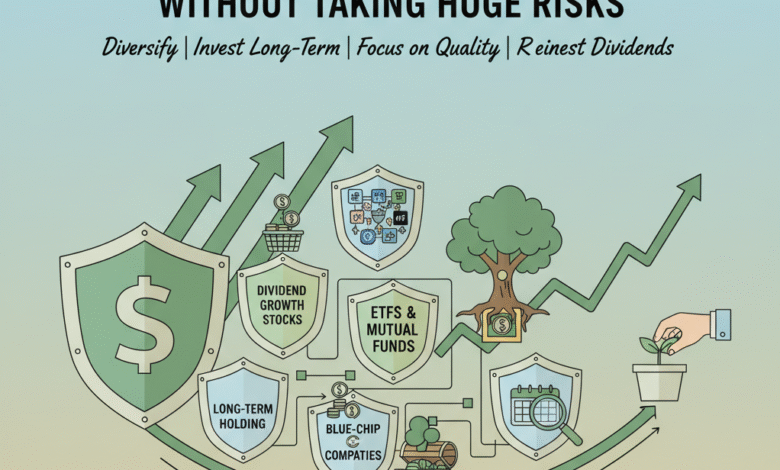Top Strategies to Earn with Stocks Without Taking Huge Risks

The stock market has created more millionaires than perhaps any other investment vehicle in history. Yet for every success story, there are countless investors who struggle to generate consistent returns. What separates profitable traders from those who underperform? The answer lies in implementing proven, strategic approaches rather than relying on luck or speculation.
Top strategies to earn with stocks revolve around understanding market fundamentals, managing risk effectively, and maintaining discipline through market cycles. Whether you’re a beginner taking your first steps into investing or an experienced trader looking to refine your approach, mastering these techniques can significantly improve your portfolio performance and long-term wealth accumulation.
Understanding the Foundation of Stock Market Success
Before diving into specific tactics, it’s essential to understand what makes stock investing profitable. At its core, earning money through equities involves buying ownership stakes in companies and benefiting from their growth through price appreciation and dividend payments.
The most successful investors recognize that the stock market isn’t a casino—it’s a mechanism for participating in economic growth and corporate profitability. Companies that increase revenue, expand market share, and generate strong cash flows typically reward shareholders over time. Your job as an investor is identifying these opportunities and positioning your capital appropriately.
Key Principles Every Investor Should Know
Several fundamental principles underpin all profitable stock strategies:
Capital preservation comes first. Before seeking extraordinary returns, protect your principal through diversification and risk management. A single devastating loss can erase years of gains.
Time horizon matters tremendously. Short-term market movements often reflect noise and emotion, while long-term trends follow business fundamentals and economic realities. Aligning your strategy with your investment timeline prevents costly mistakes.
Emotion is the enemy. Fear and greed drive most poor investment decisions. Successful traders develop systematic approaches that remove emotional impulses from their process.

Strategy #1: Value Investing for Long-Term Wealth Creation
Value investing remains one of the most reliable stock market investment strategies for building sustainable wealth. This approach involves identifying quality companies trading below their intrinsic value and holding them until the market recognizes their true worth.
How to Implement Value Investing
Start by screening for companies with strong fundamentals trading at attractive valuations. Look for these characteristics:
Low price-to-earnings ratios compared to industry peers and historical averages signal potential undervaluation. However, ensure the low multiple isn’t justified by deteriorating business conditions.
Strong balance sheets with manageable debt levels provide stability and flexibility. Companies with fortress balance sheets weather economic storms better and can capitalize on opportunities when competitors struggle.
Consistent profitability demonstrated over multiple business cycles indicates durable competitive advantages and skilled management teams.
Competitive moats such as brand strength, network effects, or proprietary technology protect against competition and support long-term profitability.
The beauty of value investing lies in its margin of safety. By purchasing quality assets below fair value, you protect downside risk while maintaining substantial upside potential when the market corrects its mispricing.
| Value Investing Metrics | What to Look For | Red Flags |
|---|---|---|
| P/E Ratio | Below industry average | Declining earnings |
| Debt-to-Equity | Less than 0.5 | Rising debt levels |
| Free Cash Flow | Positive and growing | Negative or erratic |
| ROE (Return on Equity) | Above 15% | Below 10% |
Strategy #2: Dividend Growth Investing for Passive Income
Dividend growth investing combines capital appreciation with steadily increasing passive income streams. This strategy focuses on companies with histories of consistently raising their dividend payments, providing both current income and long-term growth potential.
Building a Dividend Growth Portfolio
The most effective dividend growth strategies target companies demonstrating these qualities:
Dividend aristocrats—companies that have increased dividends for 25+ consecutive years—provide proven track records of shareholder-friendly capital allocation. These businesses typically operate in stable industries with predictable cash flows.
Payout ratios between 40-60% offer sustainability while leaving room for future increases. Companies distributing too much of their earnings as dividends may lack flexibility during downturns.
Growing underlying businesses support dividend increases over time. Stagnant companies eventually exhaust their ability to raise payouts, limiting total returns.
Starting with an initial yield of 3-4% and targeting annual dividend growth of 7-10%, investors can build substantial passive income streams that outpace inflation and provide financial security. The compounding effect of reinvesting dividends accelerates wealth accumulation dramatically over decades.
Strategy #3: Growth Investing for Maximum Capital Appreciation
Growth investing targets companies expanding revenues and earnings at above-average rates. While often more volatile than value or dividend strategies, this approach can generate exceptional returns when executed properly.
Identifying High-Quality Growth Opportunities
Successful growth investing requires distinguishing between companies with sustainable competitive advantages and those riding temporary trends:
Revenue growth rates above 15-20% annually indicate strong market demand and successful execution. However, ensure growth isn’t achieved through unsustainable practices like excessive discounting.
Expanding profit margins demonstrate operating leverage and pricing power. Companies that grow revenue while improving profitability typically deliver superior returns.
Large addressable markets provide runway for continued expansion. Even excellent companies face challenges maintaining growth rates when their markets saturate.
Innovation capabilities allow companies to stay ahead of disruption and continuously create value. Look for businesses investing meaningfully in research and development.
The challenge with growth investing lies in valuation. High-growth companies often trade at premium multiples, making timing critical. Patience for pullbacks and corrections can significantly improve entry points and ultimate returns.
| Growth vs. Value Comparison | Growth Stocks | Value Stocks |
|---|---|---|
| Typical P/E Ratio | 25-50+ | 10-20 |
| Dividend Yield | 0-2% | 3-5% |
| Revenue Growth | 15%+ | 0-10% |
| Risk Level | Higher volatility | Lower volatility |
| Best Market Conditions | Bull markets | Bear/sideways markets |
Strategy #4: Index Fund Investing for Consistent Returns
For investors seeking broad market exposure with minimal effort, index fund investing offers compelling advantages. This passive approach matches market returns while minimizing costs and eliminating individual stock selection risk.
Why Index Funds Deserve Consideration
Research consistently shows that most active fund managers underperform their benchmarks over extended periods after accounting for fees. Index funds provide several benefits:
Automatic diversification across hundreds or thousands of companies eliminates idiosyncratic risk. Poor performance from individual holdings has minimal portfolio impact.
Rock-bottom fees preserve more of your returns. While seemingly small, the difference between 0.05% and 1.5% annual fees compounds to hundreds of thousands of dollars over investing lifetimes.
Tax efficiency results from minimal turnover. Index funds rarely trigger taxable capital gains distributions, allowing wealth to compound more effectively.
Simplicity removes the burden of research, analysis, and active management. Most investors lack the time, expertise, or emotional discipline for successful stock picking.
A core portfolio allocation to broad market index funds provides stability and reliable returns, which can be supplemented with more targeted strategies for additional alpha generation.
Strategy #5: Momentum and Technical Trading
While fundamental analysis drives most long-term stock market investment strategies, shorter-term traders can profit from momentum and technical patterns. This approach requires different skills and temperament than buy-and-hold investing.
Implementing Momentum Strategies
Momentum investing capitalizes on the tendency for stocks showing strength to continue outperforming in the near term:
Relative strength indicators identify stocks outperforming their peers and the broader market. These leaders often continue their trajectories as investors increasingly recognize their potential.
Breakout patterns from consolidation periods signal new uptrends beginning. Stocks breaking above resistance levels with strong volume often experience sustained moves.
Trend following systems using moving averages and other technical indicators help traders ride profitable trends while cutting losses quickly when momentum reverses.
Risk management becomes paramount with momentum strategies. Stop-loss orders protect against sudden reversals, while position sizing limits exposure to any single idea. This approach demands more active monitoring than passive strategies but can generate substantial returns for disciplined practitioners.
Strategy #6: Sector Rotation for Economic Cycle Profits
Different market sectors outperform at various stages of economic cycles. Sophisticated investors rotate capital toward sectors positioned to benefit from current conditions while reducing exposure to those likely to underperform.
Understanding Sector Performance Patterns
Economic cycles progress through identifiable phases, each favoring different industries:
Early expansion periods favor financial stocks, consumer discretionary companies, and industrials as economic activity accelerates and credit expands.
Mid-cycle growth benefits technology, industrial, and materials companies as capital expenditures increase and productivity improvements drive profits.
Late-cycle peaks see energy and materials stocks perform well as resource constraints emerge and inflation pressures build.
Recession periods favor defensive sectors like utilities, consumer staples, and healthcare that maintain demand regardless of economic conditions.
By monitoring economic indicators and adjusting sector exposures accordingly, investors can enhance returns while managing downside risk during market transitions.
| Economic Phase | Favored Sectors | Sectors to Avoid |
|---|---|---|
| Early Recovery | Financials, Consumer Discretionary | Utilities, Staples |
| Mid Expansion | Technology, Industrials | Defensive sectors |
| Late Cycle | Energy, Materials | Financials |
| Recession | Healthcare, Utilities, Staples | Cyclicals |
Risk Management: The Foundation of Earning Consistently
No discussion of profitable stock strategies would be complete without addressing risk management. The most brilliant investment thesis means nothing if poor risk controls destroy your capital before profits materialize.
Essential Risk Management Techniques
Position sizing prevents any single investment from causing portfolio-threatening losses. Limiting individual positions to 2-5% of total capital ensures diversification benefits remain intact.
Stop-loss discipline automatically exits losing positions before small setbacks become catastrophic. While no one enjoys taking losses, accepting small defeats prevents large disasters.
Portfolio diversification across sectors, market capitalizations, and investment styles reduces correlation and smooths returns. Even the best strategies experience periods of underperformance.
Rebalancing regularly locks in gains from outperformers and redirects capital toward undervalued opportunities. This systematic approach enforces buy-low, sell-high discipline that emotions often sabotage.
Building Your Personal Investment Strategy
The most effective approach combines multiple strategies tailored to your specific circumstances, goals, and temperament. Consider these factors when designing your plan:
Time horizon determines appropriate strategy focus. Young investors can emphasize aggressive growth, while those approaching retirement should prioritize capital preservation and income.
Risk tolerance varies dramatically among investors. Honest self-assessment prevents strategy mismatches that lead to panic selling during volatility.
Available time for research and monitoring influences whether active or passive approaches suit you better. Part-time investors often achieve better results with index funds than attempting stock picking with limited attention.
Capital available affects diversification possibilities and minimum investment requirements. Smaller portfolios may need index funds or ETFs for adequate diversification.
Conclusion: Your Path to Stock Market Success
Earning money through stock market investment strategies requires education, discipline, and patience. The strategies outlined here—value investing, dividend growth, growth stock selection, index fund investing, momentum trading, and sector rotation—provide proven frameworks for building wealth.
Success doesn’t require mastering every approach. Instead, identify one or two strategies that align with your strengths and circumstances, then execute consistently. The investors who achieve financial independence aren’t necessarily the most brilliant or those who take the biggest risks. They’re the ones who develop sound strategies and maintain discipline through inevitable market fluctuations.
Start with education and paper trading to test strategies without risking capital. As confidence and competence grow, gradually deploy real money while maintaining strict risk controls. Remember that building wealth through stocks is a marathon, not a sprint. Sustainable, consistent returns compounded over decades create life-changing wealth far more reliably than attempting to strike it rich on speculative bets.
The stock market rewards those who approach it with respect, discipline, and a long-term perspective. By implementing these top strategies to earn with stocks, you’ll position yourself among the successful minority who achieve their financial goals through intelligent investing.
READ MORE : Best Strategy Forex to Earn Consistent Profits in 2025


